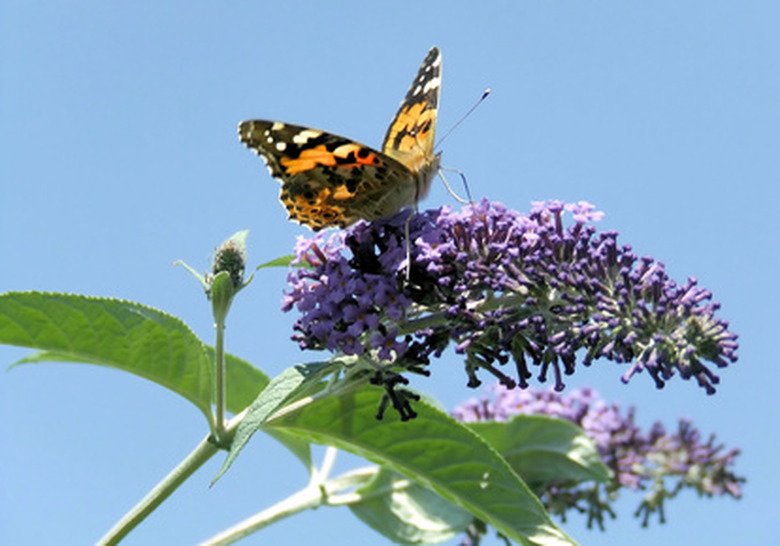Butterfly Bush Root System
Buddleia spp., or butterfly bush, is a woody perennial that produces long, showy spikes of flowers known to attract butterflies (hence the name) and hummingbirds. The non-cultivated varieties have root systems that can survive many environmental extremes, to the point that they are invasive in some states. Most species of butterfly bush have a root system designed to withstand short periods of drought and an occasional freeze, while absorbing enough nutrients to support the showy masses of blooms.
Root Type/Characteristics
Butterfly bushes have a fibrous root system designed to wind through the nutritious top layer of soil. They do not possess a tap root. While this denies the butterfly bush the anchoring that taproots provide, it also prevents problems with root rot that some deep-rooted plants can have if the long tap sits in water too long. The fibrous root system provides some anchorage, but primarily allows the butterfly bush to get the most from the nutrients and water of the growing season, then produce a plethora of seeds.
- or butterfly bush, is a woody perennial that produces long, showy spikes of flowers known to attract butterflies (hence the name) and hummingbirds.
- The fibrous root system provides some anchorage, but primarily allows the butterfly bush to get the most from the nutrients and water of the growing season, then produce a plethora of seeds.
Growing Conditions
The roots of the butterfly bush cannot sit in water for prolonged periods. They do not have proper defenses against root fungal diseases, and insufficient oxygen to the roots can cause them to drown. If, on the other hand, the roots are subject to prolonged drought, the leaves and branches wilt. A long drought during the growing season will weaken the plant, leaving it exposed to infestation and disease. So long as the soil is lightly moist and full of nutrients, the roots will support a healthy plant.
Transplanting
Fibrous root systems are easier to transplant than tap roots, which is good news for butterfly bushes. According to experiments conducted by the Royal Horticultural Society, trimming back 15 percent of the outer roots on the root ball of a butterfly bush induced the most new root growth. This, in turn, helps the bush establish faster in the new soil. Saturating the roots in rooting hormone or in a mycorrhiza inoculation also encourages root growth and root support.
- The roots of the butterfly bush cannot sit in water for prolonged periods.
- Fibrous root systems are easier to transplant than tap roots, which is good news for butterfly bushes.
Propagation
Like most shrubs, the butterfly bush can be propagated by cuttings. But this is not practiced as much as growing from seeds, because a single spike from a Buddleia davidii "Potter's Purple" can produce as much as 40,000 seeds. However, dividing a butterfly bush by separating the mature root ball into four sections provides mature plants faster. Dig up the root ball when the plant is still dormant in early spring. Use sharp garden pruners to cut off the upper stalks. Cut down through the root ball in quarters with a long, sharp knife. You can make more divisions, but the success of the clusters might not be as good.
- Like most shrubs, the butterfly bush can be propagated by cuttings.
- But this is not practiced as much as growing from seeds, because a single spike from a Buddleia davidii "Potter's Purple" can produce as much as 40,000 seeds.
Overwintering
In the northern states, the butterfly bush may die back to the roots each year. In general, the roots have a good chance of surviving the winter. Adding mulch will trap heat and moisture in the soil. Wet soil doesn't change temperature as fast as dry soil. This prevents the roots from going into shock from a sudden temperature change. The University of Nebraska Lincoln recommends planting a variety of butterfly bush that has hardier roots, Buddleia alternifolia.
